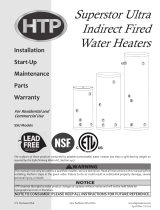
3
LP-219 Rev. 3.25.14
C. LOCATING THE BUFFER TANK................................................................................................................................................ 4
PART 3 –PIPING ......................................................................................................................................................................... 5
A. PLUMBING ................................................................................................................................................................................. 5
B. TYPICAL INSTALLATION ........................................................................................................................................................... 6
HTP CUSTOMER INSTALLATION RECORD FORM........................................................................................................................ 8
PART 1 – GENERAL SAFETY INFORMATION
A. PRECAUTIONS
This buffer tank is approved for indoor installations only. Clearance to combustible materials: 0” top, bottom, sides and back. Tank must
have room for service: 24” front and 6” sides are minimum recommended service clearances. (A combustible door or removable panel
is acceptable front clearance.) This buffer tank has been approved for closet installation, and installation on combustible flooring. Install
in a location where temperature and pressure relief valve discharge or a leak will not result in damage to the surrounding area. If such a
location is not available, install an auxiliary catch pan.
INSTALLER – Read all instructions in this manual before installing. Perform steps in the order given.
USER – This manual is for use only by a qualified heating installer/service technician. Have this buffer tank serviced/inspected by a
qualified service technician annually.
FAILURE TO ADHERE TO THE GUIDELINES ON THIS PAGE CAN RESULT IN SUBSTANTIAL PROPERTY DAMAGE, SEVERE
PERSONAL INJURY, OR DEATH.
DO NOT USE THIS BUFFER TANK IF ANY PART HAS BEEN UNDERWATER. Immediately call a qualified service technician.
NOTE: If the buffer tank is exposed to the following, do not operate until all corrective steps have been made by a qualified serviceman:
1. FIRE
2. DAMAGE
3. WATER
Any claims for damage or shortage in shipment must be filed immediately against the transportation company by the consignee.
High heat sources (sources generating heat 100
o
F / 37
o
C or greater, such as stove pipes, space heaters, etc.) may damage plastic
components of the water heater as well as plastic vent pipe materials. Such damages ARE NOT covered by warranty. It is
recommended to keep a minimum clearance of 8” from high heat sources. Observe heat source manufacturer instructions, as well as
local, state, provincial, and national codes, laws, regulations and ordinances when installing this water heater and related components
near high heat sources.
B. WHEN SERVICING THE WATER HEATING SYSTEM
To avoid electric shock, disconnect electrical supply before performing maintenance.
To avoid severe burns, allow all related water heating equipment to cool before servicing.
PART 2 – PREPARE THE BUFFER TANK
UNCRATING BUFFER TANK – Any claims for damage or shortage in shipment must be filed immediately against the transportation
company by the consignee.
COLD WEATHER HANDLING – If the buffer tank has been stored in a very cold location (BELOW 0
o
F) before installation, handle with
care until the plastic components come to room temperature.









